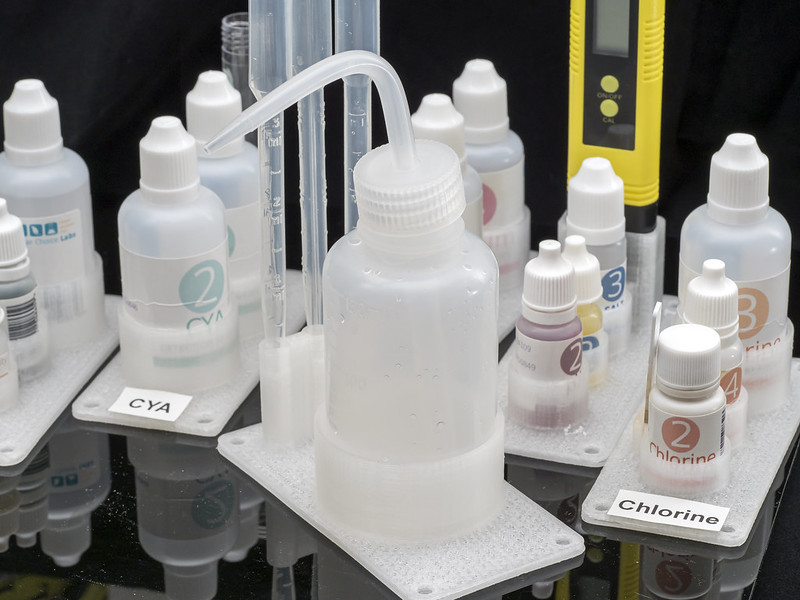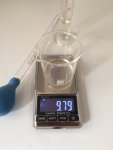Firstly I would like to thank Brett from Clear Choice Labs (CCL) for answering my questions both promptly and honestly. This is excellent customer service and the obvious choice for Australian members for their test kit resources.
Whilst the following specifically applies to my personal experience with the CCL test tube sample volume sizing there is of course potential other kits may see variations in sample size i suppose.
Last summer as part of putting up the 12x24 Bestway AGP and being keen to follow TFP process I ordered a fresh water testing kit from CCL that came with all the relevant tests. In addition we adapted a generic speed stir from ebay to handle the test tubes from the kit.
I had ordered five magnetic stirrers, on for each of the tests and sitting on my desk was a jewelers scale with 200gm total with 1/100th gram resolution that i used a lot weighing out SMD components. Ideal for weighing out sample water volumes.
I couldn't find it documented in any of the CCL doco what the volume was but a check against the lines on a couple of the tubes showed that like the taylor/tft kits 10ml was the sample volume being used. The SG of pool water for this purpose is close enough to 1.00 so that 10ml = 10grams.
All good this let me fill each test tube quickly and consistently.
Fast forward to Nov 2019 and we are getting ready to install a SWCG so I ordered and received my Salt Water test kit. Got all the bits out, filled the tube with 10gms (10ml) of water and noticed the water was above the line .... mmmm ... tip sample out and fill to the line, 9ml .... ok assumed the test used a different sample size.
Added more salt based on the test and retested on Wed 6th .... for giggles i tested using 9ml and 10ml samples, tested twice and got consistent 400ppm difference with the 10ml being 400ppm higher.
Checked the other test tubes and the CH tube had the line a little low ... around 9.5ml.
Fired off an email to CCL and Brett replied that the sample size for all their tests is 10ml and that the labels are currently applied by hand and may have small variations.
These variations generally won't be of significance for pool owners and they are working to improve the accuracy of the label placements.
However if you take in any variations reading the meniscus curve and i'm personally not great at that you could have up to 15% variation on your sample volume .... is this significant enough to be an issue ... maybe ....
My salt test tube however resulted in a 10% variation in sample size from expected and this is enough to provide a difference in the test result of reading low, this in turn could have meant I added more salt than the SWCG requires. fortunately I am sneaking up on the final value.
TLDR: If your chasing consistent same size for testing results from your test kits it's worth checking the sample volume indicating by the markings on the tube by weighing the water volume or weighing the sample size every time.
Notice i said consistent sample size, this being only one factoring many such as sample temp and drop size that lead to accurate, consistent results.
I'm sure that many will just think it's being a little OCD and it may well be but maybe the info is useful to the users here of the CCL kits.
Cheers
Whilst the following specifically applies to my personal experience with the CCL test tube sample volume sizing there is of course potential other kits may see variations in sample size i suppose.
Last summer as part of putting up the 12x24 Bestway AGP and being keen to follow TFP process I ordered a fresh water testing kit from CCL that came with all the relevant tests. In addition we adapted a generic speed stir from ebay to handle the test tubes from the kit.
I had ordered five magnetic stirrers, on for each of the tests and sitting on my desk was a jewelers scale with 200gm total with 1/100th gram resolution that i used a lot weighing out SMD components. Ideal for weighing out sample water volumes.
I couldn't find it documented in any of the CCL doco what the volume was but a check against the lines on a couple of the tubes showed that like the taylor/tft kits 10ml was the sample volume being used. The SG of pool water for this purpose is close enough to 1.00 so that 10ml = 10grams.
All good this let me fill each test tube quickly and consistently.
Fast forward to Nov 2019 and we are getting ready to install a SWCG so I ordered and received my Salt Water test kit. Got all the bits out, filled the tube with 10gms (10ml) of water and noticed the water was above the line .... mmmm ... tip sample out and fill to the line, 9ml .... ok assumed the test used a different sample size.
Added more salt based on the test and retested on Wed 6th .... for giggles i tested using 9ml and 10ml samples, tested twice and got consistent 400ppm difference with the 10ml being 400ppm higher.
Checked the other test tubes and the CH tube had the line a little low ... around 9.5ml.
Fired off an email to CCL and Brett replied that the sample size for all their tests is 10ml and that the labels are currently applied by hand and may have small variations.
These variations generally won't be of significance for pool owners and they are working to improve the accuracy of the label placements.
However if you take in any variations reading the meniscus curve and i'm personally not great at that you could have up to 15% variation on your sample volume .... is this significant enough to be an issue ... maybe ....
My salt test tube however resulted in a 10% variation in sample size from expected and this is enough to provide a difference in the test result of reading low, this in turn could have meant I added more salt than the SWCG requires. fortunately I am sneaking up on the final value.
TLDR: If your chasing consistent same size for testing results from your test kits it's worth checking the sample volume indicating by the markings on the tube by weighing the water volume or weighing the sample size every time.
Notice i said consistent sample size, this being only one factoring many such as sample temp and drop size that lead to accurate, consistent results.
I'm sure that many will just think it's being a little OCD and it may well be but maybe the info is useful to the users here of the CCL kits.
Cheers


 3D printed Clear Choice Labs test kit holders
3D printed Clear Choice Labs test kit holders 3D printed Clear Choice Labs test kit holders
3D printed Clear Choice Labs test kit holders 3D printed Clear Choice Labs test kit holders
3D printed Clear Choice Labs test kit holders 3D printed Clear Choice Labs test kit holders
3D printed Clear Choice Labs test kit holders _Z086892
_Z086892
 I guess you’ve attempted to source a cost effective, relatively accurate pre graduated or printed cylinder.
I guess you’ve attempted to source a cost effective, relatively accurate pre graduated or printed cylinder.